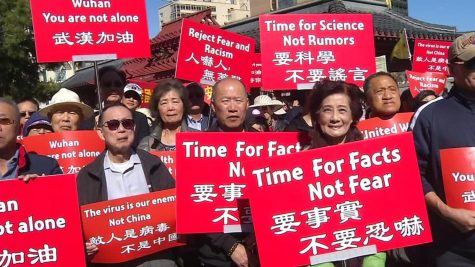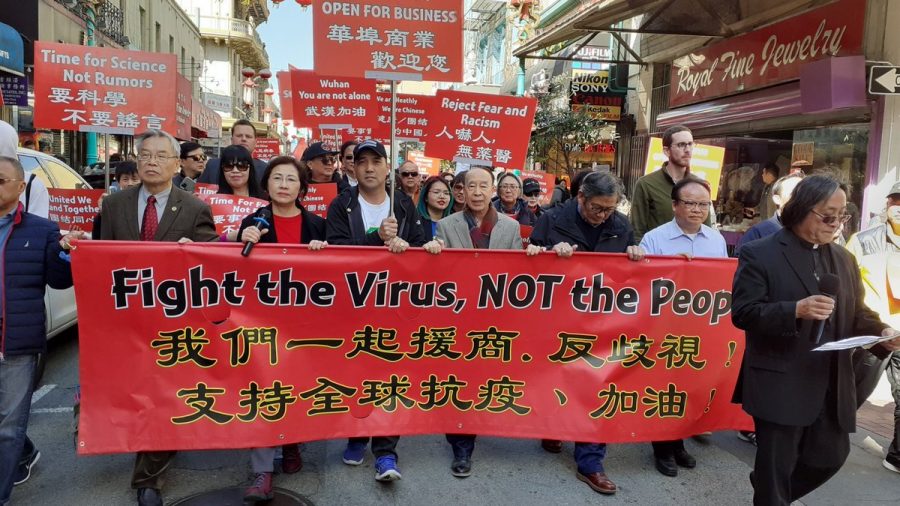I Am Not A Virus, Racism Is: A Chinese American’s Take on COVID19
April 20, 2020
The news and concerns of the people have been dominated by a dreaded disease: Coronavirus. The stock market is plummeting, countries are on shutdown, grocery stores are being raided, and people are dying in droves. America recently claimed the highest death rate in the world of over 20,000 victims. As if physical illness weren’t enough, the social sickness of xenophobia against Chinese Americans is spreading faster than the virus. Since the outbreak, Chinese people have faced harassment, racial profiling, and violent hate crimes despite being on the forefront of COVID-19 awareness. The Trump administration is only too happy to fuel the hatred, calling the disease a “Chinese virus.”
In December 2019, a string of pneumonia cases occurred in Wuhan, Hubei Province in China, believed to be linked to the Hunan Seafood Wholesale Market. The number of cases doubled every week, but local authorities refused to be honest about how the disease could spread among humans and silenced doctors who spoke out about the disease. Eventually, the Chinese government warned the World Health Organization about the serious strain. WHO declared it to be a Public Health Emergency of International Concern on January 30. Since then, over a million cases have occurred worldwide. Travel is severely restricted; countries are on lockdown, closing public spaces and ordering everyone to stay home. Hospitals are overwhelmed and undersupplied. Over 80,000 have died; in the U. S., there are over 500,000 confirmed cases and 20,000 deaths.
For Asians, COVID-19 brings a new threat: stigma and racial discrimination. All over the world, countries are turning on Asian residents, especially those of Chinese descent, accusing them of spreading the disease. In South Korea, Malaysia, and Italy, signs have been put up banning Chinese customers. In Europe and North America, reports of harassment from East Asians have been coming in. Xenophobes and racists are having a field day, using the illness to fuel anti-immigrant rhetoric. On social media, people spread false, malicious rumors that COVID-19 was developed in Chinese labs to infect Americans, that the Chinese caused it by eating bats and snakes, that Chinese food is the culprit, that the culture is unsanitary.

This is totally inaccurate and racist. For starters, COVID-19 is NOT a Chinese disease. It’s not the product of unsanitary eating habits or lifestyle. It’s a disease, not something to blame on a country or ethnicity. Secondly, it’s unclear how the virus began. Scientists hypothesize that COVID-19 originated in bats but passed to humans through an intermediary vector; possibly a pangolin, ferret, or even a housecat caught the virus from the bats and came into direct contact with people. The disease might not have even been caused by eating exotic foods; a farmer harvesting bat guano for fertilizer or an old woman petting a cat could have been the first victim of a deadly pandemic. Thirdly, most of the cases aren’t even Asian; despite a stalled response from the Wuhan government, China reacted much faster to COVID-19 by quarantining Hubei, rapidly building hospitals, and alerting the WHO. This isn’t to say that China’s government is blameless; their mistakes allowed the disease to spread across Asia. But it’s easy for Western countries to blame someone else when their own inaction, especially if they can tap into old stereotypes.
None of this is new. Chinese people have been seen as dangerous foreigners, even in recent decades when they were viewed as the “model minority” (good grades, tech companies, strong family ties). The Yellow Peril Movement of the 1800s and first half of the 1900s cited the Chinese’s uncleanliness and Oriental maladies as a motive to expel them from the country. In 1900, when there was a bubonic plague outbreak in San Francisco’s Chinatown, the local government tried to suppress rumors and cover it up before ultimately placing the blame on the residents’ housing and cuisine. History repeats itself when it is not learned.
In Europe, East Asians have been getting verbally and physically attacked. Jiye Seong-yu, a Korean interpreter living in the Netherlands, encountered two men on a scooter while biking home at night after a dance class. The men yelled “Chinese!” and tried to punch her in the back as they drove by. In Berlin, two women beat up a Chinese woman so badly she had to be hospitalized. In New York, on March 11, an Asian woman was punched in the face and heckled with racial slurs. On April 5, on a New York City bus, an Asian American woman was attacked by an unidentified woman and three teens who made racist remarks. In Midland, Texas, on April 7, an Asian American family consisting of a mother and two small children, ages 2 and 6, were non-fatally stabbed by a man who said the Chinese were infecting people. Videos of getting heckled, attacked, and even beaten at school, on the street, and on public transportation have surfaced. Even Asian medical workers are not immune; they’ve been accused of being selfish and irresponsible for going out and spreading a sickness they do not have, are not responsible for, and are risking their lives to treat. Asians have reported trying to hide their features by wearing hats, sunglasses, and masks when going out. California is currently conducting a study on coronavirus related hate crimes against Asians. What I mentioned is a taste of the hateful incidents reported daily; who knows how many more go unreported?

Despite the Yellow Peril’s return, Asian America refuses to give up. Activists and lawmakers set up online forums to discuss racist altercations. Celebrities like Awkwafina, Jeremy Lin, and Lana Condor have called out the Trump administration and general public for spreading lies. Asian churches, unions, and even private businesses have been leading the charge in awareness. Vietnamese nail salons all over the country have been donating masks and gloves to hospitals. In Salinas, California, Chinese parents at Stevenson School accumulated 47,000 masks and distributed them at a pick up station to Monterrey County. Even in the early days of COVID-19, when it was mainly in Wuhan, Chinese Americans organized massive donations of protective gear for severely undersupplied hospitals and citizens. Even though America quickly turned on us, we still show up for you.
Here are some ways to support Asian Americans during this difficult time.
- Speak up when someone says something racist or inaccurate. Most of the panic and vitriol is caused by false news or panicked rhetoric. Make sure people know that COVID-19 is NOT a Chinese disease, is not transmitted by race (no disease is), is not going to come from your average Asian person on the street, and is NOT an excuse to hate on a group of people. And if you see someone getting bullied or attacked for their race, it’s basic human decency to stand up for them.
- Support Chinese businesses. Restaurants, supermarkets, stores. We’re not sick, many of us have never been out of the country, and we practice cleanliness with or without a global pandemic to keep ourselves and our customers safe. You can get take out.
- Check out Asian activist groups. While the federal government and state governors haphazardly bid over medical supplies, Asian American unite to amass and donate gear out of the goodness of their heart. They definitely could use support these days, whether it’s money or a kind word of appreciation.
Am I concerned about the virus? Absolutely. I’m terrified that my grandmother or older relatives might get sick, especially as their assisted living facilities lock the doors and ban visitors. I feel terrible about all the deaths and pray for a vaccine.
But to be honest, the actual virus scares me less than the racism. It pains me to say that I’m less worried about getting sick with a global pandemic than getting attacked for the color of my skin. I’m more worried that the Chinese American community will be set back a century in civil rights, to the times of the Exclusion Act and Yellow Peril. I’m more worried about our communities collapsing due to lack of business. I’m more worried that a sickness will be used as an excuse to restrict immigration and justify xenophobia, even though there’s evidence that Trump’s policies (denying healthcare coverage to undocumented and recent immigrants, leaving governors to their own devices to get supplies, reopening the U. S. too soon) will allow COVID-19 to worsen. I’m more worried about getting interrogated, harassed, and kicked out of public places when the quarantine lifts because people think I spread disease. I’m more worried about getting stared at like a parasite every time I sneeze. I’ve even worried about getting assaulted in a hate crime. Fortunately, none of this hasn’t happened to me so far, but it’s happening to Asians all over the world. We like to say “We’re all in this together,” but anyone who looks different is at risk for a much older, rampant malady called racism.


